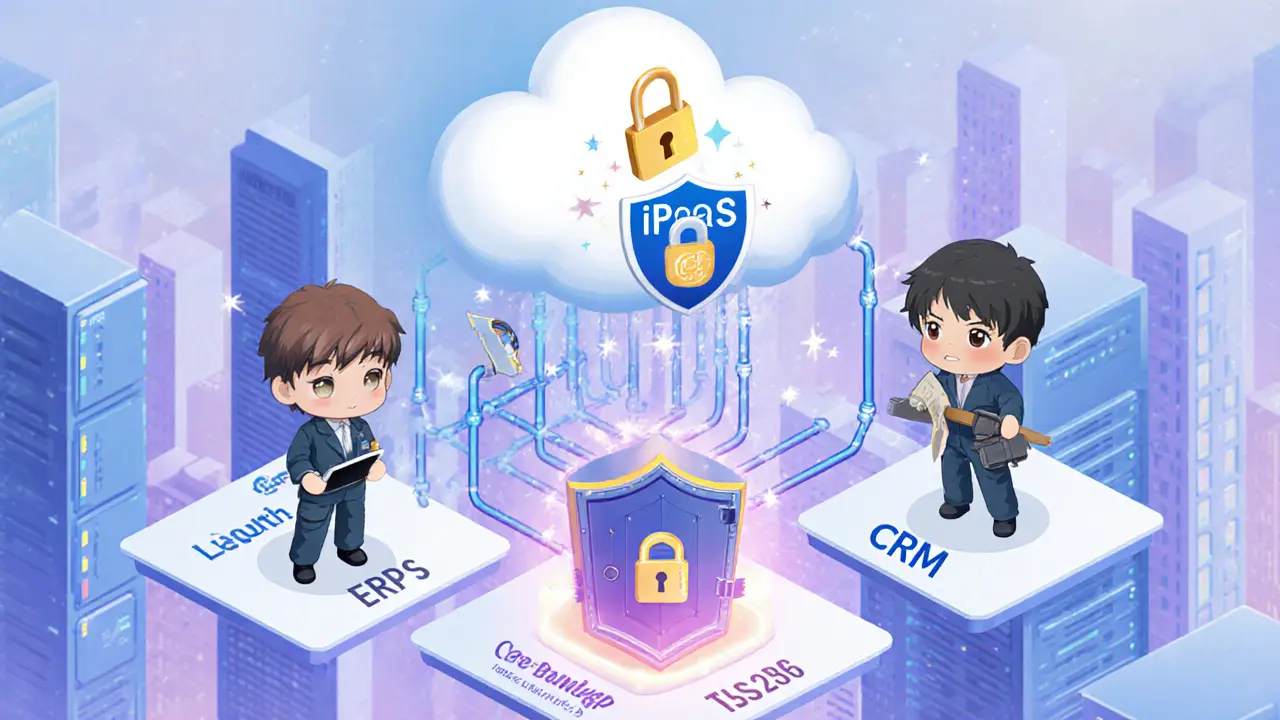BaaS Integration Planner
Integration Plan Summary
Security
OAuth 2.0, TLS 1.3, AES-256 encryption
Compliance
GDPR, PSD2, AML support
Scalability
Cloud-native architecture
Trying to add banking features to an existing product can feel like dragging a heavy safe through a narrow hallway. Banking-as-a-Service integration solves that problem by letting you plug in accounts, payments, or card issuance through well‑defined APIs instead of rebuilding a whole core banking system from scratch.
Quick Takeaways
- Start with a clear business case and pick a BaaS provider that supports OAuth, TLS and the regulations you need.
- Use an Integration Platform as a Service (iPaaS) to bridge legacy ERP, CRM or e‑commerce apps with the new banking APIs.
- Secure every data flow - authentication via OAuth/OpenID, encryption in transit (TLS) and at rest.
- Follow a three‑phase rollout: configure→test→monitor, and keep compliance checks (GDPR, PSD2, AML) in the loop.
- Future‑proof your stack with micro‑services, cloud hosting (AWS or Azure), and keep an eye on blockchain‑enabled smart contracts.
1. What Exactly Is Banking‑as‑a‑Service?
Banking-as-a-Service is a cloud‑based model that lets non‑banks embed core banking functions-like account creation, payments, and card issuance-through APIs offered by licensed financial providers. Think of it as the “plug‑and‑play” version of a traditional banking stack. Instead of buying a mainframe, you call an endpoint, send a JSON payload, and get a response that either opens an account or moves money.
Because the heavy lifting (risk management, settlement, regulatory reporting) stays with the provider, you can focus on the user experience and your unique value proposition.
2. Planning Your Integration - From Business Goal to Provider Choice
The first job is to define what banking service you actually need. Is it a simple “Buy‑Now‑Pay‑Later” flow, or a full‑blown digital wallet? Mapping the desired feature to a concrete use case avoids over‑engineering later.
Next, evaluate providers against three pillars:
- Scalability: Can the API handle spikes of 10k transactions per second?
- Compliance support: Does the provider already handle GDPR, PSD2, CCPA and AML requirements?
- Technical fit: Are there ready‑made iPaaS connectors that map your ERP or CRM fields to the BaaS data model?
Ask for a sandbox, run a few test transactions, and verify latency numbers. A provider that can give you a 200ms average response time for a card‑issuance call is usually a safe bet for consumer‑facing apps.
3. The Technical Architecture - Layers You’ll Need
At a high level, a BaaS integration looks like this:
- Core Banking APIs - the provider’s endpoints for accounts, payments, etc.
- iPaaS layer - a middleware that hosts pre‑built connectors, data transformation rules, and orchestration workflows.
- Legacy Systems - your existing ERP, CRM, or custom billing engine.
- Security envelope - OAuth 2.0 / OpenID Connect for auth, TLS1.3 for transport, and AES‑256 encryption at rest.
- Cloud hosting - AWS or Microsoft Azure for scalability and built‑in monitoring.
Here’s how the pieces talk to each other:
User → Front‑end (React / Angular) → iPaaS (REST call) → BaaS API (OAuth token) → Core Banking → Response back through iPaaS → Front‑end
Because the iPaaS sits in the middle, you can swap out the front‑end framework (React, Vue.js, Angular) without touching the banking side, and you can replace the BaaS provider later by updating the connector.

4. Three Common Integration Patterns
Depending on how many systems you need to involve, choose one of these patterns:
| Pattern | Typical Use Case | Key Benefits |
|---|---|---|
| Data Consistency Layer | Synchronizing customer records between CRM and BaaS during migration | Single source of truth, reduced duplicate accounts |
| Composite Service | Building a checkout flow that pulls pricing from ERP, account status from BaaS, and fraud score from a third‑party service | Fast prototyping, reusable service orchestration |
| Multi‑step Process | Onboarding that involves KYC verification, account opening, then card issuance across three separate systems | Clear audit trail, easy rollback at each step |
5. Step‑by‑Step Implementation Guide
Below is a practical checklist you can assign to a small devops squad.
- Assess readiness
- Inventory all legacy touchpoints (databases, APIs, message queues).
- Map data fields to the BaaS schema (e.g.,
customer_id ↔ account_holder_id). - Identify compliance gaps - do you need a Data Protection Impact Assessment (DPIA) for GDPR?
- Select and provision the provider
- Create a sandbox account, generate OAuth client‑id/secret.
- Enable OAuth for token‑based authentication and set redirect URLs.
- Configure TLS 1.3 encryption for all API traffic on your gateway.
- Set up iPaaS connectors
- Pick a cloud‑native iPaaS (e.g., MuleSoft, Dell Boomi) that offers a BaaS connector out of the box.
- Map legacy fields to the connector’s input schema; add transformation rules for date formats, currency codes.
- Define error‑handling routes - retry on 429, alert on 401.
- Build the front‑end integration
- Use a modern framework (React, Angular, Vue) to call the iPaaS endpoint via fetch/axios.
- Store the OAuth access token in a secure HttpOnly cookie; refresh it using the provider’s refresh endpoint.
- Show real‑time status (e.g., "Account creation in progress…") to keep users informed.
- Test end‑to‑end flows
- Run unit tests on each connector mapping.
- Execute integration tests in sandbox: open an account, make a payment, issue a card.
- Validate compliance logs - ensure every personal data field is encrypted and audit‑ready.
- Deploy to production
- Roll out behind a feature flag; monitor latency and error rates for the first 48hours.
- Enable cloud monitoring (AWS CloudWatch or Azure Monitor) on the iPaaS gateway.
- Schedule a post‑mortem review after the first week to capture any hidden edge cases.
6. Pitfalls to Avoid and Risk‑Mitigation Tips
Over‑customizing too early. It’s tempting to build a perfect data model before you even know how the API behaves. Start with the provider’s default schema; customize only after you’ve validated volume and performance.
Ignoring regulatory hooks. GDPR requires a right‑to‑be‑forgotten workflow. PSD2 demands Strong Customer Authentication (SCA). Build these hooks into the iPaaS flows now; retro‑fitting later is costly.
Skipping token rotation. OAuth access tokens expire; a stuck refresh flow can lock out your users. Automate rotation and log each refresh attempt for audit trails.
Under‑estimating data migration. Moving existing customer balances into a new BaaS account must be atomic. Use a two‑phase commit pattern: reserve the amount in legacy DB, then confirm with the BaaS “credit” endpoint.
Mitigation strategies:
- Maintain a sandbox‑to‑production parity checklist.
- Implement circuit‑breaker logic in the iPaaS to stop cascading failures.
- Run a quarterly compliance drill - simulate a data‑subject‑access request (DSAR).
7. Looking Ahead - Blockchain, Smart Contracts, and Beyond
Emerging tech is already nudging BaaS providers to add blockchain‑backed settlement layers. If your product plans to support digital assets, ask the provider whether they expose a smart contract API for automating conditional payouts on a blockchain. Even if you don’t need it today, having the option can future‑proof your roadmap.
Another trend is the rise of micro‑services architectural style that breaks the application into independent services for each banking function. Pairing micro‑services with an iPaaS gives you fine‑grained scaling - you can spin up extra payment‑service pods without touching the account‑creation service.
Finally, keep an eye on regulatory updates. The EU’s Digital Operational Resilience Act (DORA) will soon require real‑time incident reporting for all financial APIs. Designing logging and alerting now will save you from a scramble later.
Frequently Asked Questions
Do I need a banking license to use BaaS?
No. The BaaS provider holds the required license and handles compliance. Your role is to embed the APIs and ensure you meet data‑privacy rules that apply to your own customers.
What security standards should I enforce?
At minimum, use OAuth 2.0 with PKCE for authentication, TLS 1.3 for all network traffic, and AES‑256‑GCM for data at rest. Also enable regular key rotation and enforce least‑privilege scopes for each API call.
How do I stay compliant with GDPR and PSD2?
Document every personal data field you send to the BaaS provider, obtain explicit consent, and provide a DSAR workflow. For PSD2, make sure every payment request triggers Strong Customer Authentication (SCA) either via your front‑end or the provider’s built‑in SCA service.
Can I switch providers after I’m live?
Yes, but plan for data migration and API version differences. A well‑structured iPaaS layer abstracts most calls, making the switch a matter of updating connector mappings and re‑certifying compliance.
Is blockchain really necessary for BaaS?
Not yet for most consumer apps. It adds complexity and cost. Consider it only if you need immutable transaction records or plan to issue digital assets.




Corrie Moxon
November 11, 2024 AT 12:50Great overview! I especially like the emphasis on starting with a clear business case before diving into the tech. It keeps the project focused and avoids unnecessary rework.
Jeff Carson
November 11, 2024 AT 14:30Solid guide. From a Canadian perspective, the iPaaS recommendation hits the sweet spot for legacy ERP integration. 👍 It’s also nice to see GDPR mentioned – we deal with PIPEDA and the overlap helps.
Just a heads‑up: make sure your cloud provider has a Canadian data‑residency option if that matters to your customers.
Anne Zaya
November 11, 2024 AT 16:10Thanks for the clear steps. The checklist format makes it easy to hand off to the dev team. I’ll add it to our Confluence page.
Emma Szabo
November 11, 2024 AT 17:50What a fantastic deep‑dive! The article walks us through the entire journey of plugging BaaS into an existing stack, and it does so with flair.
First, the reminder to lock down a crystal‑clear business case cannot be overstated – chasing a shiny API without a real user problem is a recipe for wasted sprint cycles.
Second, the provider evaluation matrix (scalability, compliance, technical fit) is spot on; I’d even add a fourth column for developer experience, because a clunky SDK can cripple velocity.
The security checklist – OAuth 2.0, TLS 1.3, AES‑256 – reads like a safety net for the modern dev, and the suggestion to rotate tokens automatically is a lifesaver against credential leakage.
I love the suggestion to use an iPaaS as a translation layer. It lets us keep the front‑end framework (React, Vue, Angular) untouched while swapping out the banking provider later – truly a future‑proof architecture.
The three‑phase rollout (configure → test → monitor) mirrors the classic continuous‑delivery pipeline, and I’d recommend feature‑flags for the initial roll‑out, just as the article notes.
When it comes to data migration, the two‑phase commit pattern described is pure gold – it guarantees atomicity between legacy DB and BaaS credit calls, preventing ghost balances.
The compliance hooks (GDPR right‑to‑be‑forgotten, PSD2 SCA) are baked into the iPaaS flows, which is a clever way to keep audit logs tidy.
On the monitoring side, the tip to hook AWS CloudWatch or Azure Monitor directly into the iPaaS gateway ensures we get real‑time latency alerts without building custom dashboards.
The pitfalls section is brutally honest – over‑customizing too early is a common temptation, and the article’s advice to start with the provider’s default schema saves countless hours.
Blockchain is mentioned as an optional future‑layer; I agree it’s overkill for most consumer apps today, but having the API endpoint ready could be a differentiator for fintechs eyeing digital assets.
Finally, the nod to upcoming regulations like DORA shows that the author is thinking ahead, which is the hallmark of a seasoned engineer.
Overall, this guide is a lighthouse for any product team embarking on a BaaS adventure. It blends strategic foresight with tactical detail, and the colorful language keeps it engaging from start to finish.
Fiona Lam
November 11, 2024 AT 19:30Listen, the guide is fine but it glosses over the real pain – legacy code that can’t be touched. You’re going to spend weeks just getting the iPaaS to talk to that ancient ERP. Expect a maze of custom adapters and a lot of hair‑pulling.
OLAOLUWAPO SANDA
November 11, 2024 AT 21:10The article is missing the obvious – you can’t just slap a BaaS on top and expect it to work. Your old system will choke on new API calls. Simple fix: rewrite the integration layer.
Alex Yepes
November 11, 2024 AT 22:50While I appreciate the optimism expressed, it is imperative to consider the contractual obligations that arise when integrating third‑party financial services. A thorough review of the Service Level Agreements (SLAs) and data‑processing addendums is required to mitigate legal exposure.
Sumedha Nag
November 12, 2024 AT 00:30Honestly, rewriting the whole integration layer just because the guide says so is overkill. Most of those legacy systems have adapters already – you just need to enable them.
Holly Harrar
November 12, 2024 AT 02:10Quick tip: when mapping fields between your CRM and the BaaS, watch out for date formats. I ran into a bug where US MM/DD/YYYY got interpreted as DD/MM/YYYY in the sandbox, causing a dozen failed onboarding attempts.
Vijay Kumar
November 12, 2024 AT 03:50One thing to add: if you’re on a custom application, consider containerizing the iPaaS connectors with Docker. It simplifies scaling and lets you version‑control the integration code alongside your app.
Edgardo Rodriguez
November 12, 2024 AT 05:30Interesting read; however, the omission of detailed error‑handling strategies-such as exponential back‑off, circuit‑breaker patterns, and idempotency keys-leaves a critical gap in the operational robustness of a BaaS integration; these mechanisms are essential to maintain service continuity under load spikes and network instability.
mudassir khan
November 12, 2024 AT 07:10The guide is overly optimistic-real‑world compliance testing is far more tedious; you’ll spend weeks just proving GDPR and PSD2 adherence, not to mention constant audit requests that cripple agile cycles.
Bianca Giagante
November 12, 2024 AT 08:50I totally agree with the step‑by‑step checklist; it respects the need for a structured rollout while also leaving space for flexibility. It’s a balanced approach that many teams will find useful.
Andrew Else
November 12, 2024 AT 10:30Sure, great… another “plug‑and‑play” promise that will probably break in production.
Susan Brindle Kerr
November 12, 2024 AT 12:10Honestly, this reads like a corporate handbook written by someone who has never actually wired a banking API. The prose is bland, the advice generic, and the optimism forced.
Jared Carline
November 12, 2024 AT 13:50While the article provides a useful framework, it neglects to address the geopolitical considerations of data residency; enterprises operating across borders must ensure that their BaaS provider complies with local sovereignty regulations, lest they incur legal repercussions.
raghavan veera
November 12, 2024 AT 15:30Feeding the mind with such step‑by‑step guides is useful, yet we must also remember that every integration is a living organism that evolves; static checklists can become obsolete as standards shift.
Danielle Thompson
November 12, 2024 AT 17:10👍 Great guide! This will help my team get started quickly. 🚀